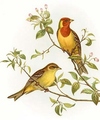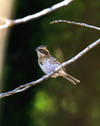Genus Emberiza
Brown-rumped Bunting - The Brown-rumped Bunting is a species of bird in the Emberizidae family. It is found in Benin, Burkina Faso, Cameroon, Central African Republic, Chad, Democratic Republic of the Congo, Ivory Coast, Ethiopia, Gambia, Ghana, Guinea, Guinea-Bissau, Kenya, Mali, Mauritania, Niger, Nigeria, Senegal, Sudan, Togo, and Uganda. Its natural habitat is subtropical or tropical moist lowland forests.
Yellow-breasted Bunting - This bird is similar in size to a Reed Bunting, but longer-billed. The breeding male has bright yellow underparts with black flank streaks, brown upperparts, black face and throat bar, and a pink lower mandible.
Red-headed Bunting - It breeds in central Asia. It is migratory, wintering in India. Its status in western Europe, where it is a potential vagrant, is confused by escapes, especially as this species is more commonly recorded than the closely related Black-headed Bunting, despite the latter have a more westerly breeding range. Reports in Britain have declined dramatically over recent years, co-inciding with the decline in Asiatic imports for the cage-bird trade.
Gray-hooded Bunting - The Grey-necked Bunting or Grey-hooded Bunting is a species of bird in the Emberizidae family. It breeds along a wide distribution range from the Caspian Sea to the Altai in Central Asia and winters in parts of Southern Asia. Like other buntings it is found in small flocks.
Cabanis's Bunting - The Cabanis's Bunting is a species of bird in the Emberizidae family. It is found in Angola, Burkina Faso, Cameroon, Central African Republic, Chad, Republic of the Congo, Democratic Republic of the Congo, Ivory Coast, Equatorial Guinea, Gabon, Ghana, Guinea, Liberia, Malawi, Mali, Mozambique, Nigeria, Rwanda, Sierra Leone, Sudan, Tanzania, Togo, Uganda, Zambia, and Zimbabwe. Its natural habitats are subtropical or tropical dry forests and dry savanna.
Cretzschmar's Bunting - It breeds in Greece, Turkey, Cyprus and the coastal countries along the eastern edge of the Mediterranean. It is migratory, wintering in the Sudan. It is a very rare wanderer to western Europe.
Cape Bunting - Its habitat is rocky slopes and dry weedy scrub, mainly in mountains in the north of its range. Its lined cup nest is built low in a shrub or tussock. The 2-4 eggs are cream and marked with red-brown and lilac.
Yellow-browed Bunting - It breeds in eastern Siberia, and is migratory, wintering in central and southern China. It is a very rare wanderer to western Europe.
Rock Bunting - It breeds in northwest Africa, southern Europe east to central Asia, and the Himalayas. It is partially migratory, with northern populations wintering further south, mainly within the breeding range of the resident southern populations. It is a rare wanderer to western Europe.
Cinereous Bunting - It breeds in southern Turkey and southern Iran, and winters around the Red Sea in northeast Africa and Yemen. A few isolated populations just about maintain a foothold within European borders, on islands in the Aegean Sea. Cinereous Bunting breeds on dry stony mountain slopes. Its normal clutch is three eggs.
Meadow Bunting - It is 15 to 16.5 cm long. The male is mostly rufous-brown with dark streaks on the back. The boldly-patterned head is brown with white eyebrow, moustachial stripe and throat and grey sides to the neck. The outer tail-feathers are white and the legs are pinkish-brown. Females are similar but are duller and paler with a less well-defined head pattern.
Cirl Bunting - It breeds across southern Europe, on the Mediterranean islands and in north Africa. It is a resident of these warmer areas, and does not migrate in winter. It is common in all sorts of open areas with some scrub or trees, but has a preference for sunny slopes.
Yellowhammer - The Yellowhammer is a robust 15.5–17 cm long bird, with a thick seed-eater's bill. The male has a bright yellow head, yellow underparts, and a heavily streaked brown back. The female is much duller, and more streaked below. The familiar, if somewhat monotonous, song of the cock is often described as A little bit of bread and no cheese.
Yellow-headed Bunting - It is found in China, Japan, North Korea, South Korea, Myanmar, Russia, and Taiwan. Its natural habitats are temperate forests and subtropical or tropical dry forests.
Golden-breasted Bunting - There are three subspecies:
Grey-hooded Bunting - It is 15 to 16 cm in length. The plumage is mostly brown with dark streaks. The male has a grey crown and nape with dark streaks, chestnut ear-coverts and bands of black and chestnut across the breast. There is a rufous patch on the shoulders and the rump is also rufous. Females are similar to the males but duller with a less distinct head and breast pattern. First-winter birds are plainer but show warm brown ear-coverts and have an obvious ring around the eye.
Ortolan Bunting - A native of most European countries and western Asia the Ortolan migrates in autumn to tropical Africa, returning at the end of April or beginning of May. Its distribution throughout its breeding range seems to be very local, and for this no obvious reason can be assigned. It was said in France to prefer wine-growing districts; but it certainly does not feed upon grapes, and is found equally in countries where vineyards are unknown. It reaches as far north as Scandinavia and beyond the Arctic Circle, frequenting corn-fields and their neighbourhoods. It is an uncommon vagrant in spring and particularly autumn to the British Isles.
Lark-like Bunting - The Lark-like Bunting is a species of bird in the Emberizidae family. It is found in Angola, Botswana, Democratic Republic of the Congo, Lesotho, Namibia, South Africa, Swaziland, Zambia, and Zimbabwe. Its natural habitat is subtropical or tropical dry shrubland.
Koslow's Bunting - Emberiza koslowi is restricted to the eastern part of the Qinghai-Tibetan Plateau, in eastern Tibet and southern Qinghai, China, where several large valleys cut into the plateau, including those of the Tongtian River , the Lancang Jiang and the Nu Jiang . It is known by just a few scattered records in this inaccessible and poorly known area, but it appears to be genuinely rather scarce and localised.
Pine Bunting - The Pine Bunting breeds across much of temperate Asia, migrating south to central Asia, north India and southern China in winter. It is common in all sorts of open land with some scrub or trees, including cultivation, but has a greater preference for open forest than the closely related Yellowhammer. It is a rare vagrant to western Europe, but often winters in NE Italy and Tuscany.
Black-headed Bunting - It breeds in southeast Europe east to Iran. It is migratory, wintering in India. It is a rare but regular wanderer to western Europe.
Pallas's Bunting - It breeds across northern and central Asia across to Mongolia. It is a migrant, which winters in south east Asia. It is a very rare vagrant to western Europe, but has occurred as far west as Great Britain.
Little bunting - This is a small bunting at 12-13.5 cm in length. It has a heavily streaked brown back and white underparts with fine dark streaking. With its chestnut face and white malar stripe, it resembles a small female Reed Bunting, but has black crown stripes, a white eye-ring, and a fine dark border to the rear of its chestnut cheeks. Sexes are similar.
Rustic bunting - It breeds across northern Europe and Asia. It is migratory, wintering in south east Asia, Japan, and eastern China. It is a rare wanderer to western Europe.
Chestnut Bunting - It is a fairly small bunting, 14 to 15 cm in length. The tail is fairly short with little or no white on the outer feathers. Breeding males have bright chestnut-brown upperparts and head. The breast and belly are yellow with streaks on the sides. Non-breeding males are similar but duller with the chestnut partly hidden by pale fringes to the feathers. The female is mostly dull brown with dark streaks above while the underparts are mainly pale yellow. The rump is dull chestnut and the throat is buff.
Common reed-bunting - It breeds across Europe and much of temperate and northern Asia. Most birds migrate south in winter, but those in the milder south and west of the range are resident. It is common in reedbeds and also breeds in drier open areas such as moorland and cultivation.
Socotra Bunting - Its natural habitat is subtropical or tropical high-altitude shrubland. It is threatened by habitat loss.
Black-faced Bunting - It breeds in southern Siberia across to northern China and northern Japan. It is migratory, wintering in northeast India, southern China and northern southeast Asia. It is a very rare wanderer to western Europe.
House Bunting - It is a resident breeder of dry country from northeast Africa , east through southwest Asia to northwestern India. Its natural food consists of insects when feeding young, and otherwise seeds.
Japanese Yellow Bunting - It is 14 cm long and has a conical, grey bill, pinkish-brown feet and brown eyes. The male is grey-green above with black streaks on the back. The underparts are yellow-green with streaks on the flanks. It has black lores, a narrow black chin, a pale eyering and white outer tail-feathers. There are two bars on the wing, formed by pale tips to the median and greater wing-coverts. The female is similar to the male but paler without the black on the lores and chin. The species has a twittering song and a soft 'tsip' call.
Cinnamon-breasted Bunting - The Cinnamon-breasted Bunting is a species of bird in the Emberizidae family. It is found in Angola, Benin, Botswana, Burkina Faso, Burundi, Cameroon, Central African Republic, Chad, Republic of the Congo, Democratic Republic of the Congo, Ivory Coast, Djibouti, Egypt, Eritrea, Ethiopia, Gabon, Gambia, Ghana, Guinea, Kenya, Lesotho, Liberia, Malawi, Mali, Mauritania, Mozambique, Namibia, Niger, Nigeria, Oman, Rwanda, Senegal, Sierra Leone, Somalia, South Africa, Sudan, Swaziland, Tanzania, Togo, Uganda, Yemen, Zambia, and Zimbabwe. Its natural habitats are dry savanna, subtropical or tropical dry shrubland, and subtropical or tropical dry lowland grassland.















